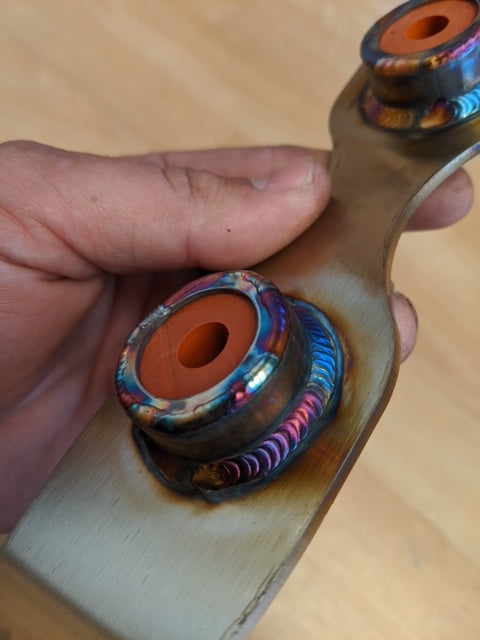How to Get Rainbow Welds: A Complete Guide for TIG Welders
Rainbow welds—those shimmering blue, gold, and purple hues along a TIG weld bead—are not only eye-catching, but also an indicator of specific welding conditions. Whether you’re chasing them for aesthetics on stainless steel or titanium, or trying to avoid them for critical applications, understanding what causes rainbow colors is key.
In this guide, we’ll explain:
-
What causes rainbow welds
-
Which gas lenses help achieve them
-
The best shielding gas to use
-
When and why rainbow colors should be cleaned off

What Causes Rainbow Welds in TIG Welding
Rainbow colors on a weld are caused by oxidation—the reaction between hot metal and oxygen in the atmosphere. The exact color depends on heat, shielding gas coverage, and cooling speed.
The color change is the result of interference in the oxide layer on the metal surface:
-
Light straw/gold = minimal oxidation
-
Blue and purple = moderate oxidation
-
Dark blue or gray = heavier oxidation
On materials like stainless steel and titanium, this effect is most visible because the chromium and titanium oxides reflect light differently.

Gas Lenses That Help Achieve Clean Rainbow Welds
A gas lens is a TIG torch accessory that improves shielding gas coverage, creating a laminar flow that better protects the weld from atmospheric contamination.
To get consistent, clean rainbow colors:
-
Large Gas Lenses – Allow you to extend the tungsten farther from the cup for better visibility while maintaining coverage.
-
#12 or Larger Cups – Wider coverage area to shield both the puddle and the heat-affected zone (HAZ).
-
Screened Gas Lenses – Disperse argon evenly, preventing turbulence that can dull the colors.
Using a quality gas lens kit ensures oxygen doesn’t reach the weld while it’s still hot, helping produce those vivid hues without gray oxidation.

Best Shielding Gas for Rainbow Welds
The go-to gas for rainbow welds is 100% Argon. It’s inert, so it won’t chemically react with the hot metal, and it provides the stable shielding needed for vibrant color.
For specialty work:
-
Argon + Helium mixes can increase heat input, which may shift the color pattern.
-
High-purity Argon (99.999%) is essential for titanium work where contamination must be minimized.
When Rainbow Welds Should Be Cleaned Off
While rainbow welds look great, in food-grade, aerospace, or high-pressure applications, any oxidation—even if colorful—can reduce corrosion resistance and mechanical properties.
Why cleaning matters in critical welds:
-
Oxide layers can trap contaminants
-
Reduced chromium content at the surface of stainless steel lowers corrosion resistance
-
Industry codes often require post-weld cleaning or passivation
Cleaning methods:
-
Chemical passivation with citric or nitric acid
-
Mechanical cleaning with a stainless steel brush or abrasive
-
Electropolishing for high-purity work
FAQ: Rainbow Welds in TIG Welding
Q: Why are some rainbow welds more colorful than others?
A: Color variation depends on heat input, cooling speed, and shielding gas coverage. Higher heat and slower cooling tend to produce deeper blues and purples.
Q: Can I get rainbow welds on mild steel?
A: Mild steel can show some color, but stainless steel and titanium produce more vivid and consistent rainbow patterns due to their oxide properties.
Q: Do I need a special TIG torch for rainbow welds?
A: You can use a standard TIG torch, but a gas lens kit and larger ceramic cups will improve gas coverage and produce better color.
Q: Will rainbow welds pass inspection?
A: In artistic or decorative projects, yes. In food-grade, aerospace, or high-pressure work, they often won’t, as colors indicate oxidation that must be cleaned off.
Q: What gas flow rate should I use?
A: Typically 15–20 CFH for stainless steel, but larger cups and outside conditions (like wind) may require adjustments.
Final Thoughts
Rainbow welds are the result of heat control, shielding gas quality, and proper gas lens selection. If you’re welding for art, fabrication projects, or custom automotive work, mastering these techniques will help you achieve that signature look. But if you’re working in regulated industries, remember—those colors may need to be removed for performance and safety reasons.
